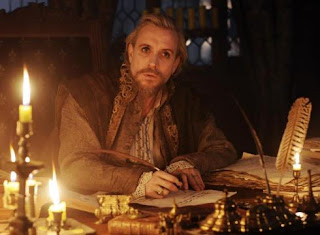 |
| Portrait by Hans Eworth; thought to be Lady Eleanor Brandon or her daughter, Lady Margaret Clifford |
Lady Eleanor and her husband had one surviving child, Lady Margaret, who was born in 1540. Lady Margaret would carry on her mother's claim to the throne under the final will of King Henry VIII after the Grey sisters which included Lady Jane Grey. Margaret married Henry Stanley, 4th Earl of Derby in 1554.
The Portrait
There is a discrepancy as to who the sitter is in the Hans Eworth portrait which is featured. The coat of arms in the top left corner, which may have been added later, are the impaled arms (those of a husband and wife) of Henry Clifford, 2nd Earl of Cumberland, and his wife Lady Eleanor, daughter of Charles Brandon, 1st Duke of Suffolk and Mary Tudor, Dowager Queen of France. As a result the painting has been frequently exhibited in the past as a portrait of Lady Eleanor, regardless of the fact that she died in 1547, well before the date of this portrait [the roman numerals MDLX at the top right = 1560]. It is, however, a rule of heraldry that impaled arms are not used by the children of a marriage, as they would have their own. Hence the later addition and erroneous use of the arms here suggests that the identity of the portrait was already unclear only two or three generations after it was painted, a situation by no means unusual amid the frequent early deaths, multiple marriages, and shifting alliances and fortunes of the most powerful families of the Tudor era. Later the portrait was thought to represent the only child of Eleanor and Henry to survive infancy, Margaret. Unfortunately the inscription on the right which might have provided a check (Margaret would have been aged 25-28 at the time of this portrait) has been truncated; although the Roman numerals of the year can apply only to 1565-8, the age of the sitter cannot be ascertained with any useful accuracy. The National Portrait Gallery has an online sketch of this portrait identified as Lady Eleanor, but the portrait remains in dispute.[5][6]
Another unfortunate aspect of the portrait is the clothing; the clothing does not match the time period of Lady Eleanor Brandon. The dress is third quarter of the 16th century and is of Spanish influence.
According to Richard Davey. The sisters of Lady Jane Grey and their wicked grandfather, E.P. Dutton and co., 1912:
The Lady Eleanor Brandon was a better looking woman than her sister Frances. When her tomb in Skipton Church was disturbed in the seventeenth century her skeleton which was in perfect condition proved her to have been very tall and large boned whereas the Lady Frances was of medium stature. Lady Eleanor, if we may judge by her portrait, which hangs at Skipton Castle, was pretty rather than beautiful. The writer confesses that the portrait at Skipton did not impress him as that of one who could have put forward the slightest pretensions to good looks; the cheeks are high, the forehead abnormally broad, the eyes however are fine, and the hair fair but the complexion according to this venerable picture must have been quite ghastly. The portrait is very badly painted; a poor thing worth little as a work of art but none the less interesting.The site for the Tate Gallery concludes that the painting is still unidentified, yet there is an identical sketch on the site for the National Portrait Gallery identified as Lady Eleanor. Who's who?
Another proposal for the sitter is given as Hon. Margaret Wentworth, daughter of Thomas Wentworth, 1st Baron and his wife Margaret Fortescue. Sir Thomas was a nephew of Queen Jane Seymour's mother, Margaret Wentworth. Thomas's daughter, Margaret, married three times; Sir John, Baron Williams of Thame; Sir William Drury; and Sir James Croft. The new identification is given by Dr. Roy Strong based on the comparison to her sister, Jane Wentworth, Lady Cheney [below].
 |
| Jane Wentworth, Baroness Cheney of Toddington |
That is one of the problems of portrait identification within the Tudor era.
 |
| Queen Katherine Parr, NPG |
 |
| Melton Constable portrait formerly labeled Lady Jane Grey; now re-labeled as Queen Katherine Parr |
So for now, the portrait remains one of four options: "unknown", "Lady Eleanor Brandon, Countess of Cumberland","Lady Margaret Clifford, Countess of Derby", or "Margaret Wentworth".
Sources:
3. Lawrence Manley, "From Strange's Men to Pembroke's Men: 2 "Henry VI" and "The First Part of the Contention".", Shakespeare Quarterly, vol. 54, No. 3 (Autumn, 2003), pp. 253-287.
4. Sir Sidney Lee. Dictionary of national biography, Volume 54, Smith, Elder, & co., 1898. pg 70. Google eBook
5. Eleanor Clifford (née Brandon), Countess of Cumberland, probably by Alfred Thomas Derby, after Unknown artist, Purchased, 1893, Reference Collection NPG D23066. National Portrait Gallery
6. The Tate Gallery 1984-86: Illustrated Catalogue of Acquisitions Including Supplement to Catalogue of Acquisitions 1982-84, Tate Gallery, London 1988, pp.66-8. Tate Collections
- Kathy Lynn Emerson "Who's Who in Tudor Women".
Written and researched by Meg McGath










